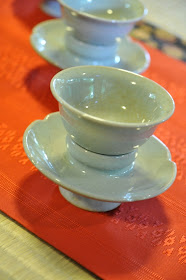Cultivar: Jade (Tsui Yu/Cui Yu) Oolong (Taiwan Nr 13)
Origin: Zhu Shan, Nantou County, Taiwan
Harvested on March 20, 2013
Process: Ball shaped Oolong with medium roast.
Test brewing in a porcelain gaiwan and 3 classic cups. No weighing of the dry leaves and no timing of the brews.
1 - Appearance
The leaves are small with few stems and the color appears dark green. It looks very well sorted, the kind of process that is used for competition Oolong.
The color of the brew is dark yellow and has good clarity.
2 - Fragrances
The dry leaves have a very pleasant roasting scent that mixes well with the natural scent of the fresh tea. It's a familiar scent that transports you to one of those old Taiwanese tea shops that still roast their teas. These scents are quite intense thanks to the roasting. They combine fruity, honey and fresh sensations.
3 - Taste
It has a slight astringency and bitterness, but the taste that dominates is mellow and sweet. It has plenty of 'body' or structure to borrow from the wine tasting vocabulary. The roasting is most present in the first brew and it makes the tea feels stronger, riper and sweeter.
4 - Body sensations
The taste lingers for some time in the mouth and creates a smooth and warm feeling in the throat and down to the stomach.
Roasted Oolong leaves take longer to open up. With this tea, we see that the leaves expand and return almost to their original state. Even the color remains fairly green.
This is a sign of excellent roasting skills: the tea's flavors are stronger, the taste sweeter, and at the same time the freshness of the leaves is still well preserved.
It doesn't have the elegance and fine notes of a high mountain Hung Shui Oolong, but it has almost everything else.
Thanks to its low price, it's a tea that can be brewed daily, in a big or small teapot. Here I'm using a gaiwan for analysis, but this is a tea that would benefit from the use of an Yixing teapot.
One way to appreciate great teas is also to experience more humble teas from time to time, especially when they are so easy to drink.
This tea also offers a good opportunity to practice your brewing skills and try to make it taste the best it can. It won't break your heart (and your wallet) if you make a mistake.
My Chaxi is inspired by this union of green freshness and (roasted) warmth. Enjoy!
































































